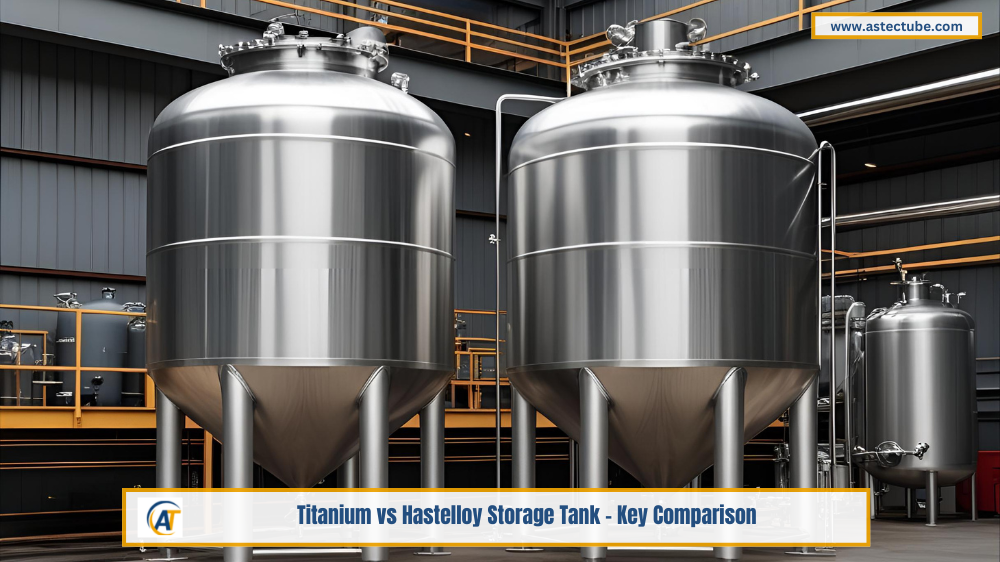When it comes to selecting the right material for industrial storage tanks, especially for highly corrosive and high-temperature environments, Titanium storage tanks and Hastelloy storage tanks are among the top choices. Both offer exceptional resistance to corrosion and strong mechanical performance, but they serve different industrial needs based on their specific chemical properties, application suitability, and cost factors.
This blog will help you understand the key differences between Titanium and Hastelloy storage tanks so that you can make an informed decision for your project or plant.
1. Material Composition and Grades
Titanium Tanks are usually manufactured using Grade 2 (commercially pure) or Grade 5 (Ti-6Al-4V) titanium. Titanium is known for its lightweight properties, high strength-to-weight ratio, and outstanding corrosion resistance in seawater and chlorine-heavy environments.
Hastelloy Tanks, on the other hand, are generally fabricated from Hastelloy C276 or Hastelloy C22, both nickel-molybdenum-chromium alloys. These grades are designed for extreme chemical resistance, especially in strong oxidizers, reducing agents, and acidic solutions such as hydrochloric, sulfuric, and nitric acid.
2. Corrosion Resistance
Titanium storage tanks offer excellent resistance to chlorides, seawater, and some acids. They form a stable oxide film that protects the metal from further attack. However, Titanium may not perform as well in reducing acid environments such as hydrochloric acid.
Hastelloy storage tanks are specifically engineered for highly corrosive chemical environments, including both oxidizing and reducing media. Hastelloy C276 and C22 are resistant to pitting, crevice corrosion, and stress corrosion cracking — making them ideal for chemical processing, waste treatment, and high-acid storage applications.
3. Mechanical Strength and Durability
While Titanium is lightweight and strong, Hastelloy has a higher tensile and yield strength, especially at elevated temperatures. For high-temperature applications (above 300°C), Hastelloy C276 tanks outperform Titanium due to their ability to maintain structural stability.
That said, Titanium pressure vessels are often preferred when weight is a concern, such as in aerospace or marine systems, due to their low density and high fatigue resistance.
4. Temperature and Pressure Handling
Titanium tanks are highly reliable at moderate temperatures (up to 400°C), but their performance declines in extremely acidic and high-temperature settings. In contrast, Hastelloy tanks can withstand temperatures exceeding 600°C in many cases, while maintaining excellent chemical resistance under pressure.
This makes Hastelloy pressure vessels ideal for pharmaceutical, fertilizer, and petrochemical plants where storage systems face aggressive chemicals at high temperatures and pressures.
5. Applications
Titanium Storage Tanks are commonly used in:
-
Marine and offshore applications
-
Desalination plants
-
Power generation facilities
-
Aerospace fuel systems
-
Chlorine processing units
Hastelloy Storage Tanks are preferred for:
-
Chemical process industries
-
Pharmaceutical production
-
Nuclear waste handling
-
Paper & pulp manufacturing
-
Fertilizer and acid production
6. Cost Considerations
Titanium is more abundant than Hastelloy and often more cost-effective for large-scale systems where extremely aggressive chemicals are not involved. However, the initial investment in Hastelloy tanks is justified by their superior resistance in extremely harsh chemical environments and their reduced need for maintenance or replacement.
If the application involves only seawater or chloride-heavy media, a Titanium storage tank might be more economical and efficient. But if the system deals with mixed acids and oxidizers, investing in Hastelloy C276 tanks offers longer operational life and reduced downtime.
7. Availability and Fabrication
Both Titanium vessels and Hastelloy vessels require specialized welding and fabrication processes. However, Titanium is more difficult to weld and machine, making Hastelloy easier to work with for complex custom designs. Reputable suppliers offer custom-built storage tanks and Hastelloy pressure vessels that meet ASME and ASTM standards.
Conclusion
Both Titanium and Hastelloy storage tanks have their advantages and are engineered for high-performance environments. The choice depends on the nature of the chemicals involved, temperature and pressure conditions, and budget.
If your operation handles highly oxidizing or reducing agents at high temperatures, Hastelloy C276 storage tanks or Hastelloy C22 pressure vessels will deliver maximum protection. For lighter weight and marine-related applications, Titanium tanks offer a corrosion-resistant, economical solution.
For long-term performance, ensure your tank supplier provides quality assurance certifications, third-party inspection, and custom fabrication to meet your specific industrial requirements.

